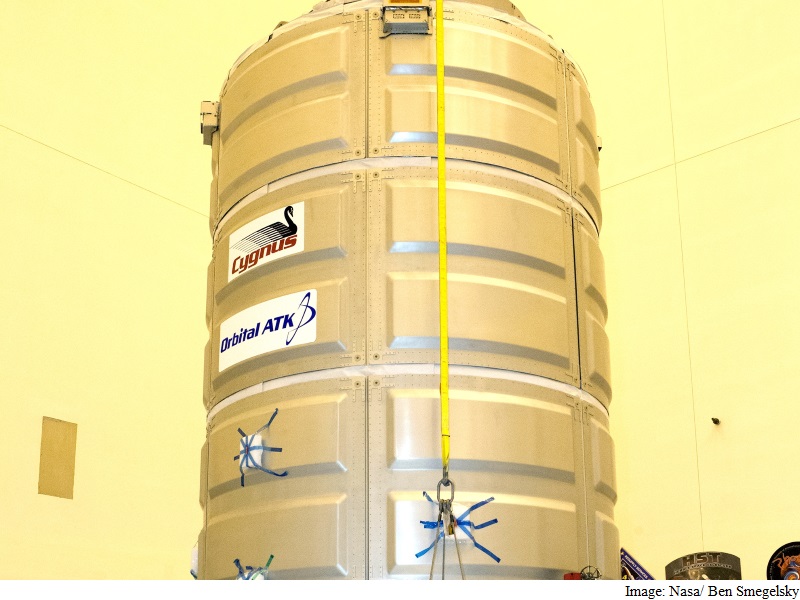- Home
- Science
- Science News
- ISS Set to Receive Sticky, Stony, and Sizzling Science
ISS Set to Receive Sticky, Stony, and Sizzling Science

Come March 22 and Nasa's commercial partner Orbital ATK will launch its Cygnus spacecraft into orbit atop a United Launch Alliance Atlas V rocket for its fifth contracted resupply mission to the International Space Station.
The flight, known as Orbital ATK CRS-6, will deliver investigations to the space station to study fire, meteors, regolith, adhesion, and 3D printing in microgravity.
In the decades of research into combustion and fire processes in reduced gravity, few experiments have directly studied spacecraft fire safety under low-gravity conditions.
None of these experiments have studied sample and environment sizes typical of those expected in a spacecraft fire.
The "Saffire-I" investigation will provide a new way to study a realistic fire on an exploration vehicle, which has not been possible in the past because the risks for performing such studies on manned spacecraft are too high.
Instruments on the returning Cygnus will measure flame growth, oxygen use and more. Results could determine microgravity flammability limits for several spacecraft materials, help to validate Nasa's material selection criteria, and help scientists understand how microgravity and limited oxygen affect flame size.
A less heated investigation called "Meteor Composition Determination" will enable the first space-based observations of meteors entering Earth's atmosphere from space, the US space agency said in a statement.
A more "grounded" Strata-1 probe will study the properties and behaviour of regolith - the impact-shattered "soil" found on asteroids, comets, the Moon and other airless worlds.
From grounded to gripping, another investigation launching takes its inspiration from small lizards. The "Gecko Gripper" investigation tests a gecko-adhesive gripping device that can stick on command in the harsh environment of space.
Once adhered, the gripper can bear loads up to 20 pounds. The gripper can remain in place indefinitely and can also be easily removed and reused.
From adhesion to additive, the new Additive Manufacturing Facility (AMF) will also be part of the cargo. Additive manufacturing (3D printing) is the process of building a part layer-by-layer, with an efficient use of the material.
The facility is capable of producing parts out of a wide variety of space-rated composites, including engineered plastics.
The ability to manufacture on the orbiting laboratory enables on-demand repair and production capability, as well as essential research for manufacturing on long-term missions.
Get your daily dose of tech news, reviews, and insights, in under 80 characters on Gadgets 360 Turbo. Connect with fellow tech lovers on our Forum. Follow us on X, Facebook, WhatsApp, Threads and Google News for instant updates. Catch all the action on our YouTube channel.
Related Stories
- Samsung Galaxy Unpacked 2025
- ChatGPT
- Redmi Note 14 Pro+
- iPhone 16
- Apple Vision Pro
- Oneplus 12
- OnePlus Nord CE 3 Lite 5G
- iPhone 13
- Xiaomi 14 Pro
- Oppo Find N3
- Tecno Spark Go (2023)
- Realme V30
- Best Phones Under 25000
- Samsung Galaxy S24 Series
- Cryptocurrency
- iQoo 12
- Samsung Galaxy S24 Ultra
- Giottus
- Samsung Galaxy Z Flip 5
- Apple 'Scary Fast'
- Housefull 5
- GoPro Hero 12 Black Review
- Invincible Season 2
- JioGlass
- HD Ready TV
- Laptop Under 50000
- Smartwatch Under 10000
- Latest Mobile Phones
- Compare Phones
- Redmi Note 15 5G
- Redmi Note 15 Pro 5G
- Redmi Note 15 Pro+ 5G
- Lava Play Max
- Poco C85 5G
- Honor Magic 8 Lite
- Jolla Phone
- Realme P4x 5G
- Asus ProArt P16
- MacBook Pro 14-inch (M5, 2025)
- OnePlus Pad Go 2
- Poco Pad M1
- Just Corseca Skywatch Pro
- Honor Watch X5
- Acerpure Nitro Z Series 100-inch QLED TV
- Samsung 43 Inch LED Ultra HD (4K) Smart TV (UA43UE81AFULXL)
- Asus ROG Ally
- Nintendo Switch Lite
- Haier 1.6 Ton 5 Star Inverter Split AC (HSU19G-MZAID5BN-INV)
- Haier 1.6 Ton 5 Star Inverter Split AC (HSU19G-MZAIM5BN-INV)

















